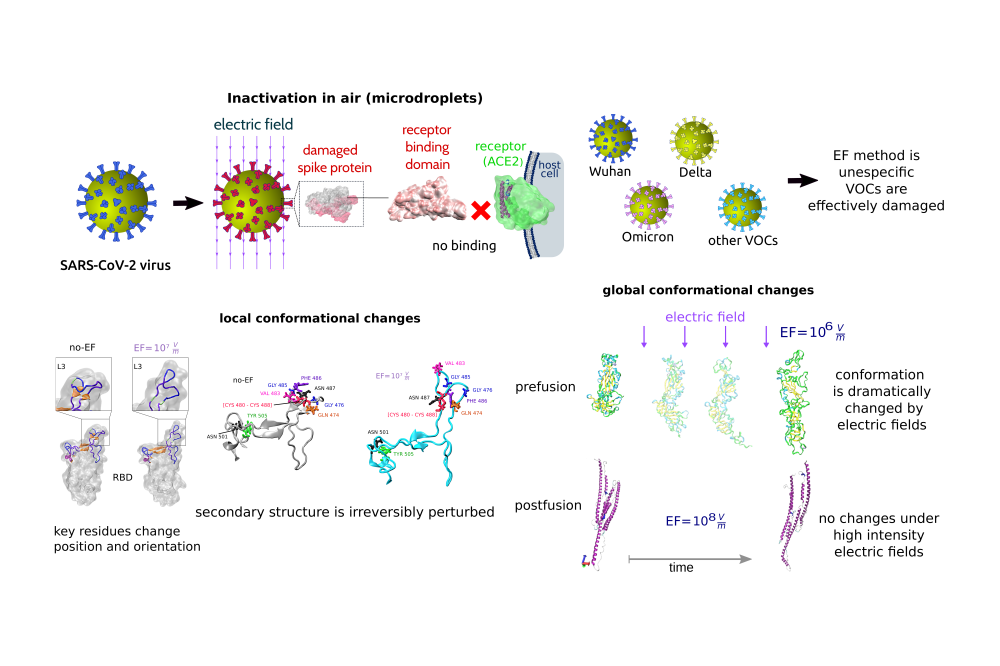Einleitung
The spike glycoprotein's interaction with the ACE2 receptor on the host cell is the crucial initial step for virus entry. In its prefusion state, the S protein, like other class 1 viral fusion proteins, exhibits metastability, which plays a significant role in optimizing and regulating its functions. So far, mostly biochemical methods are being tested in order to prevent binding of the virus to ACE2. We demonstrated, using molecular dynamics (MD) simulations, that external electric fields (EEF) of easily achievable and moderate strengths can dramatically destabilise the prefusion structure of S protein, inducing irreversible structural damage. We found that the spatial arrangement of key recognition residues is completely altered, leading to impaired recognition function and ACE2 binding. Our findings reveal that electric fields impact both the prefusion state of the wild type and various variants. Moreover, when exposed to strong electric fields, the postfusion state of the S protein remains structurally unchanged, indicating a higher level of stability. Remarkably, while the structural flexibility of S allows the virus to improve its probability of entering the cell, it is also the origin of the surprising vulnerability of S upon application of electric fields of strengths at least two orders of magnitude smaller than those required for damaging most proteins.
Methoden
The initial conformation of proteins was obtained from two available PDB structures. The simulations were performed using the GROMACS package (version 2019.4) with CHARMM-36 force field parameters. The resultant trajectory files were read and postprocessed using GROMACS tools and the MDAnalysis Python library. The Adaptive Poisson-Boltzmann Solver (APBS) algorithm was used to calculate all potential maps on selected frames from the MD trajectories. Molecular docking calculations to obtain proteinreceptor interactions were performed using pyDock web server. The VMD software was used to visualise the MD trajectories and to draw the molecular representations.
Ergebnisse
We studied the effect of EEF on the secondary and tertiary structures of the S protein, from the original Wuhan strain and from different variants of concern that emerged over time. For this purpose, we performed molecular dynamics simulations for each one at different EEF intensities (105, 106, 107, 108,109 V m −1), followed by EEF-off simulations that were carried out during various Lichtenberg2 HPC projects. For the all variants studied, we found that EEF are able to induce global conformational changes in the prefusion state of spike glycoprotein, consequently affecting the stability of its folding states. The EEF-driven major shape alterations occur within and between the different subunits of the S protein, leading to modifications in the free energy landscape, which allows the protein to surpass potential barriers. Once the EEF is applied, a new minimum is achieved, and even after the EEF is turned off, this new equilibrium state remains stable. Principal component analysis (PCA) indicates that once the prefusion S protein settles into a new basin of equilibrium, which is different for each EF intensity, there is no return to the initial state upon switching off the EEF. We also studied how the EEF specifically disturb the stability of the Receptor Binding Domain (RBD) and, in particular, of residues that are vital to the local interaction with ACE2. Our results demonstrate that during the EF-on simulations, the secondary structure of the RBD, in all studied S variants, was locally disrupted. Specifically, the L3 loop, known to play a key role in the S-ACE2 interaction, undergoes a transition from a compact structure with two beta-sheets to an open and completely unstructured coil. This alteration affects the spatial arrangement of critical residues involved in the RBD-ACE2 interaction. Moreover, the pyDock calculations reveal a decline in the binding affinity with the ACE2 receptor, indicating reduced ACE2 recognition. To compare the stability between the prefusion and postfusion states of the S protein, additional MD simulations were conducted under the influence of an electric field for the postfusion structure. Interestingly, no changes in the secondary structure were observed throughout the MD trajectory of the postfusion structure, despite the presence of a highintensity field. This finding is consistent with the inherent stability of the postfusion conformation.
Diskussion
Summarizing, our simulations predict that for the prefusion state of the S protein, for all the considered variants, an external electric field as low as 105 V m−1 produces severe global structural damage and local conformational reorganization of the RBD-ACE2 interface. This affects the attachment of SARS-CoV-2 to the host cell. Our findings suggest the existence of a clean physical method to weaken SARS-CoV-2 without requiring additional biochemical processing. Furthermore, since the method is largely nonspecific, it may be applicable to other mutations in the S protein or to other membrane proteins of different virus types. A paper detailing this research has been published in Nature Communications.




